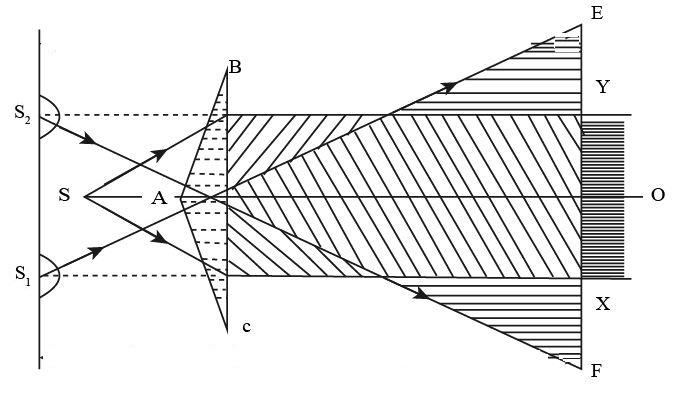
In Fresnel’s biprism experiment, coherent sources are obtained from an incoherent source using division of
(A) Amplitude
(B) Wavefront
(C) Phase
(D) None
Answer
489k+ views
1 likes
Hint: You need to apply the basics of the Fresnel biprism in order to solve this question. So you should firstly know about Fresnel biprism and its applications. You should also know about the coherent and incoherent sources, which will help you to answer this question.
Complete step by step answer:
A Fresnel biprism is a type of prism having a double thin prism that is placed over each other having a very low refracting angle. In the experiment, a light generated from a single source is made to pass through two virtual sources. It is due to the refraction in a prism, and thus the two sources act as coherent sources.

As we see the figure, it can be seen that the light falls on the prism, emerging from the slit when the light rays fall on the prism and get divided into two. One goes to the lower half of the prism, which appears to originate from the virtual source
Thus, the interference in this prism is obtained by the division of the wavefront.
Note:
You can be confused between the amplitude and wavefront, but the answer cannot be amplitude. It is so because the wavefront of the incident wave is divided to get two virtual sources.
Complete step by step answer:
A Fresnel biprism is a type of prism having a double thin prism that is placed over each other having a very low refracting angle. In the experiment, a light generated from a single source is made to pass through two virtual sources. It is due to the refraction in a prism, and thus the two sources act as coherent sources.

As we see the figure, it can be seen that the light falls on the prism, emerging from the slit when the light rays fall on the prism and get divided into two. One goes to the lower half of the prism, which appears to originate from the virtual source
Thus, the interference in this prism is obtained by the division of the wavefront.
Note:
You can be confused between the amplitude and wavefront, but the answer cannot be amplitude. It is so because the wavefront of the incident wave is divided to get two virtual sources.
Latest Vedantu courses for you
Grade 11 Science PCM | CBSE | SCHOOL | English
CBSE (2025-26)
School Full course for CBSE students
₹41,848 per year
Recently Updated Pages
Master Class 4 Maths: Engaging Questions & Answers for Success

Master Class 4 English: Engaging Questions & Answers for Success

Master Class 4 Science: Engaging Questions & Answers for Success

Class 4 Question and Answer - Your Ultimate Solutions Guide

Master Class 11 Economics: Engaging Questions & Answers for Success

Master Class 11 Business Studies: Engaging Questions & Answers for Success

Trending doubts
Give 10 examples of unisexual and bisexual flowers

Draw a labelled sketch of the human eye class 12 physics CBSE

Differentiate between homogeneous and heterogeneous class 12 chemistry CBSE

a Tabulate the differences in the characteristics of class 12 chemistry CBSE

Why is the cell called the structural and functional class 12 biology CBSE

Differentiate between insitu conservation and exsitu class 12 biology CBSE




